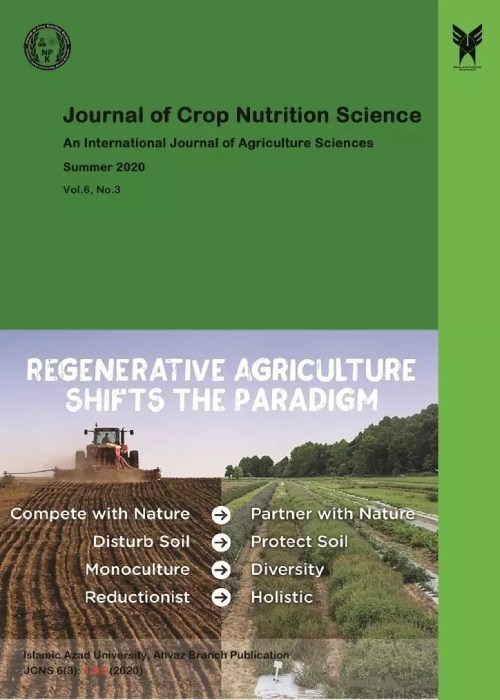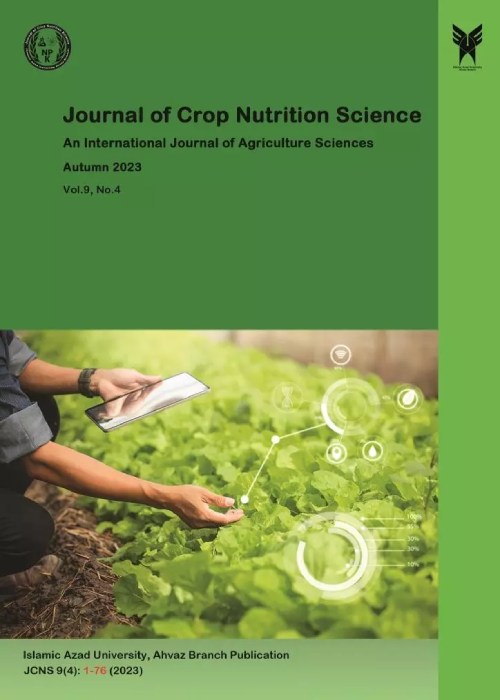فهرست مطالب

Journal of Crop Nutrition Science
Volume:6 Issue: 3, Summer 2020
- تاریخ انتشار: 1399/06/11
- تعداد عناوین: 6
-
Pages 1-15BACKGROUNDSalinity is one of the important a biotic stresses limiting growth and development and the capacity to tolerate salinity is a key factor in crop productivity.OBJECTIVESThe aim of this study was to evaluate the response of sugarcane varieties to uptake and transport of ionic elements under salinity stress.METHODSThis research was carried out to via factorial experiment based on completely randomized design with three replications along 2013 year. The treatments included salinity stress (S1: 0 ds.m-1 S2: 3 ds.m-1 S3: 6 ds.m-1 S4: 9 ds.m-1) and different genotypes (V1: IRC9904, V2: IRC9906, V3: C2, V4: IRC9901, V5: C3, V6: C4, V7: CP48-103, V8: CP57-614, V9: CP69-1062). Studied genotypes included of three old commercial varieties (CP69-1062, CP57-614, CP48-103), three new commercial varieties (IRC9901, IRC9904, IRC9906) and three clones tolerate salinity (C2, C3, C4).RESULTAccording result of analysis of variance effect of different level of salinity, genotypes and interaction effect of treatment on all studied traits was significant at 1% probability level. Salinity stress decreased the concentration of potassium and calcium and also increased the concentration of sodium and chlorine in the roots and shoots, so reduced plant biomass, especially in more sensitive genotypes. It seems that in addition to the importance of the root in controlling the uptake of ionic elements, there are mechanisms in other organs that are involved in the uptake and transport of these elements and genotypes also affects it.CONCLUSIONMean comparison result indicated the highest amount of sodium and chlorine transfer to the shoot was obtained from 9 ds.m-1 salinity level and IRC9906 variety and the lowest one belonged to 0 ds.m-1 salinity level and C4 clone.Keywords: Calcium, chlorine, Potassium, sodium, Transport ions, Uptake
-
Pages 16-34BACKGROUNDManagement of nutrients, especially nitrogen, in order to economic production, maintains sustainable agriculture, provide food security and prevent environmental pollution is considered to have an important priority. Also select and propose responsible genotype to environmental conditions is a great factor.OBJECTIVESThe current research was conducted to evaluate effect of Azotobacter and nitrogen fertilizer on Nitrogen consumption efficiency indices of some safflower genotypes under dry land conditions.METHODSThis research was conducted via combined analysis factorial experiment based on randomized complete blocks design with three replications along 2015-16 and 2016-17 year. The treatments included different level of Nitrogen (N0: nonuse of fertilizer or biofertilizer as control, N1: Seed inoculation with Azotobacter + nonuse of urea chemical fertilizer, N2: Seed inoculation with Azotobacter + 50% nitrogen from urea source, N3: 100% nitrogen from urea source according soil test) and 6 genotypes (G1: 312-S6-697, G2: PI-401478, G3: PI-253895, G4: PI-306974, G5: Padideh and G6: Sina).RESULTResult of analysis of variance revealed effect of nitrogen factor and genotypes on all studied traits was significant. In this study combined application of 50% nitrogen chemical fertilizer with Azotobacter in terms of seed yield was not significantly different from the treatment of 100% nitrogen fertilizer application and the nitrogen use efficiency in this treatment was significantly higher than the application of 100% chemical fertilizer.CONCLUSIONSina genotype and combined use of 50% nitrogen fertilizer with Azotobacter to produce maximum yield and reduce the use of nitrogen fertilizer in order to achieve sustainable agriculture and environmental protection in the dry land conditions and can be recommended to producers in studied region.Keywords: Azotobacter, Nitrogen harvest index, Nitrogen uptake, Nutrition, Oilseed
-
Pages 35-48BACKGROUNDNutrient management plays an great role for obtaining satisfactory yields and to increase crop productivity. It may be achieved by the involvement of organic sources, biologic fertilizers, and micro-nutrients.OBJECTIVESThe current study was done to investigate the effect of application of bio-fertilizers containing nitrogen and phosphorus biologic fertilizer on some quantitative and qualitative parameters of Faba bean and relation between measured traits.METHODSThis research was carried out via factorial experiment based on randomized complete blocks design with four replications along 2013 year. The treatments included Nitroxin biologic fertilizer (N1: nonuse of Nitroxin or control, N2: 250 cc.1000m2, N3: 500 cc.1000m2) and phosphorus biofertilizer (P1: nonuse of Phosphorus biofertilizer or control, P2: 100 gr.ha-1, P3: 150 gr.ha-1).RESULTAccording result of analysis of variance effect of different level of Nitroxin and phosphorus biofertilizer on all studied traits was significant. Also interaction effect of treatments on number of seed per pod, number of pod per plant and plant height was not significant. Evaluation mean comparison result of interaction effect of treatments on all measured traits revealed the highest amount of seed yield (5096 kg.ha-1), biologic yield (9230 kg.ha-1), 1000-seed weight (1450 gr.ha-1) Seed protein percentage (24%), leaf area index (4.5) and harvest index (53.2%) were noted for N3P3 treatment and lowest amount of mentioned traits belonged to control. The most significant correlation between seed yield and Biologic yield (r=0.95**), number of pod per plant (r=0.81**), 1000-seed weight (r=-0.73**), number of seed per pod (r=0.68**) and Harvest index (r=0.67**), respectively was observed.CONCLUSIONFinally according result of current research application 500 cc.1000m2 Nitroxin and 150 gr.ha-1 Phosphorus biofertilizer had the highest amount of studied traits and it can be advice to producers in studied region.Keywords: Leaf area index, nitrogen, Nutrition, Pulse, Yield
-
Pages 49-61BACKGROUNDManagement of nutrients, especially nitrogen, in order to wheat economic production and maintain sustainable agriculture to provide food security, is considered to have an important priority. Fertilizer management plays an important role for obtaining satisfactory yields and increase crop productivity.OBJECTIVESThis research was done to evaluate response of crop production and agrophysiological traits of wheat genotypes to apply different level of nitrogen fertilizer.METHODSCurrent study was conducted according split plots experiment based on randomized complete block design with three replications. Main factor included four levels of nitrogen fertilizer (N1=60, N2=120, N3=180, N4=240 kg.ha-1) and sub plots consisted four genotypes of Bread (V1: S85-19 as line, V2: Chamran) and Durum (V3: Behrang, V4: Dena) Wheat.RESULTAccording result of analysis of variance effect of different level of nitrogen fertilizer, genotypes and interaction effect of treatments on all studied traits was significant at 5% probability level. Evaluation mean comparison result of interaction effect of treatments on all measured traits revealed the highest amount of seed yield (610 gr.m-2), number of spike per square meter (1010), rate of redistribution (162.97 gr.m-2), efficiency of redistribution (0.24 gr.gr-1), contribution of redistribution (50.50%), rate of current photosynthesis (737.67 gr.m-2), efficiency of current photosynthesis (0.95 gr.gr-1) and contribution of current photosynthesis (83.50%) were noted for 180 kg.ha-1 nitrogen fertilizer and Chamran genotype and lowest amount of mentioned traits belonged to nonuse of fertilizer and S-85-19 line treatments.CONCLUSIONFinally according result of current study application 180 kg.ha-1 nitrogen fertilizer and Chamran genotype had the maximum amount of studied traits and it can be advice to producers in studied region.Keywords: Durum, Nutrition, physiology, Remobilization, Seed yield
-
Pages 62-75BACKGROUNDGibberellins (GAs) are growth hormones strongly involved in a wide variety of physiological activities. Currently, gibberellins are commercially used to enhance phenotypic characteristics, earliness, and productivity of many vegetable and ornamental crops.OBJECTIVESThe current study was conducted to evaluate the effect different amount and time of apply Gibberellin acid on morphological characteristics and crop production of Broad bean.METHODSThis research was carried out via factorial experiment based on randomized complete blocks design with three replications along 2010 year. The treatments included different concentration of Gibberellin (nonuse of Gibberellin or control, 5 ppm, 50 ppm and 250 ppm) and time of application Gibberellin (Vegetative growth before flowering, flowering until pod emergence, Pod emergence until grain filing).RESULTAccording result of analysis of variance effect of different amount, time of applies Gibberellin acid and interaction effects of treatments on all studied traits were significant. Evaluation mean comparison result of interaction effect of treatments on all measured traits revealed the highest amount of plant height (91.46 cm), node number (29.35), node length (4.98 cm), stem number (13.30), pod length (17.79 cm), seed yield (2899 kg.ha-1), Stem dry weight (1693 kg.ha-1) and Leaf dry weight (958 kg.ha-1) were noted for 50 ppm and vegetative growth before flowering and lowest amount of mentioned traits belonged to nonuse of Gibberellin acid and apply Gibberellin at pod emergence until grain filing.CONCLUSIONFinally according result of current study apply 50 ppm Gibberellin acid at vegetative growth before flowering had the highest amount of studied traits and it can be advice to producers in studied region.Keywords: Growth regulator, Hormone, Node, POD, Pulse
-
Pages 76-85BACKGROUNDIn organic agriculture, one management goal is to increase and maintain soil quality with a high biological activity. Organic cropping system often has to deal with a scarcity of readily available nutrients in contrast to high input cropping system which relies widely available on soluble fertilizers. Nanotechnology such as using Nano-scale fertilizer particles may offer new techniques in improving existing crop management.OBJECTIVESCurrent study was carried out to assess effect of different level of vermicompost and Nano iron fertilizer on morphological characteristics, chlorophyll content and crop production of corn.METHODSThis research was conducted according split plot experiment based on randomized complete blocks design with three replications along 2018 year in research farm of Islamic Azad University of Ahvaz Branch. Main plot included three level of vermicompost (V0: nonuse of vermicompost or control, V1: 5 t.ha-1 vermicompost, V2: 10 t.ha-1 vermicompost) was consumed at planting stage. Also subplots consisted four level of Nano iron fertilizer (F0: Nonuse of Nano iron fertilizer or control, F1: 0.002 L.ha-1, F2: 0.004 L.ha-1 and F3: 0.006 L.ha-1 Nano iron fertilizer) was used at 3 to 4 leaves stage.RESULTAccording result of analysis of variance effect of different level of vermicompost and iron Nano fertilizer on all studied traits was significant but interaction effect of treatments only on ear loss length was not significant. Assess mean comparison of interaction effect of treatments on all measured traits revealed the highest amount of seed yield (545.7 gr.m-2), plant height (273.6 cm), Stem diameter (22.67 mm) ear length (26.73 cm), ear diameter (67.57 mm) and Chlorophyll index (2.951 spad) were noted for V2F3 treatment and lowest amount of mentioned traits belonged to control.CONCLUSIONUse 10 t.ha-1 vermicompost with 0.006 L.ha-1 iron Nano fertilizer led to produce the highest amount of crop production, morphological traits and chlorophyll content and can be advice to farmers.Keywords: Corn, Ear length, Nutrition, Plant height, Stem diameter


